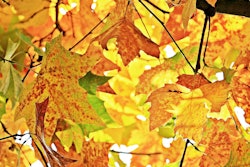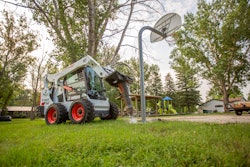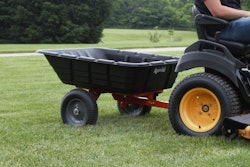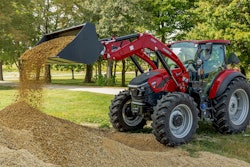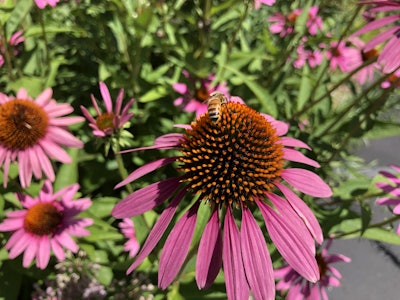 Photo: Jill Odom/Total Landscape Care
Photo: Jill Odom/Total Landscape CareSeptember is National Honey Month, but bees provide so much more than this sweet treat alone and customers don’t have to be professional beekeepers in order to lend this struggling species a helping hand.
Habitat loss, improper use of pesticides and pests like varroa mites and the pathogens they carry have all impacted bee populations in recent years and continued coverage has boosted the general public’s awareness of the problem.
“One of the things that we can then do as a landscape company is to deliberately craft messages to our customers that say that they can be part of the solution,” says Paulita LaPlante, managing partner and chief strategy officer for Prescription Landscape, based in St. Paul, Minnesota. “It can be in a small way or it can be in a big way.”
By offering your professional services to customers, communities can become better informed as to the right plants to grow and when to properly use pesticides.
“Public concerns about bees and pollinators provide landscapers an opportunity to showcase their expertise, education, professionalism and value,” says Frank Wong, Ph.D., senior regulatory affairs consultant for Bayer.
What makes a bee-friendly landscape?
If a client approaches you about adding a pollinator garden or you’ve suggested creating a bee-friendly landscape, take the time to educate them on what methods are effective.
“A simple question about, ‘How do I make a bee-friendly landscape?’ can have a complicated answer related to choosing the best plant species for the soil type and location, diversifying species, learning blooming patterns and choosing the appropriate pest controls,” Wong says. “Saying something simple like, ‘Just don’t use pesticides,’ isn’t really a great answer.”
One of the best practices is to make sure your clients are selecting flowers that are viable nectar and pollen sources that are diverse as well.
“Honeybees need at least an acre of forage to support a hive during a year, but it can’t come all at one time,” Wong says. “Having landscapes that provide sources of nectar and pollen throughout the year when bees are active is important, so mixing and matching different plant species that bloom at different times is key.”
An easy misconception is that cultivars will provide the same value for pollinators as a true native when this is not the case.
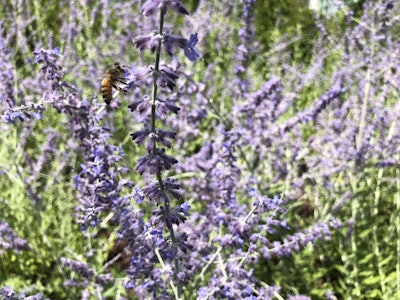 Photo: Jill Odom/Total Landscape Care
Photo: Jill Odom/Total Landscape Care“Cultivars usually are not good sources of either pollen or nectar,” LaPlante says. “To put it in the most simplistic terms, if a bee visits a plant that does not produce the amount of nectar that the native species does, then that bee will expend more energy and not get the same amount of energy in return in the form of nectar or pollen. You are therefore introducing stress to that bee. The stress in itself makes that bee more susceptible to other assaults in its environment. It weakens it, so it’s important to always look for native species and to resist the temptation to go with something just because it has the same generic name.”
Choosing a variety of flowers also allows landscapers to attract a number of different bee species.
“If we look at different types of plants, they are specifically attractive to different sorts of bees,” LaPlante says.
Some of the preferences are due to the physical size or shape of the bees and/or the flowers. Long-tongued bees favor flowers with long tubes with nectar at the bottom, while others may only be able to raise their young with pollen from particular plants.
These sorts of picky bees are known as specialists, while other species of bees can collect pollen from a wide range of plants and are known as generalists.
Even when you’re creating a bee-focused landscape for clients, don’t forget that by selecting a diverse collection of different blooming plants you are also helping a number of other pollinators and beneficial insects as well.
“Bees are incredibly important,” LaPlante says. “But there’s a whole group of insects out there that aren’t as cute as bumblebees and honeybees, but they’re equally important.”
Prescription Landscape installed a 5,000-square-foot pollinator garden at Minnehaha Academy this year. The garden supports more than 400 bee species native to Minnesota, along with other pollinators as well. It features Minnesota native plants like smooth penstemon, wild bergamot, bee balm, coneflowers and Iriquois beauty chokeberry.
Just as a bee-friendly landscape can be used to attract certain species, LaPlante says it’s important to discourage unwelcome visitors like aggressive stinging insects, such as yellow jackets, by removing what attracts them. She says they’re typically an issue around apple trees in Minnesota and they can mitigate the issue by removing fallen and rotting fruit.
Maintenance
When it comes to maintenance for a bee-friendly landscape, LaPlante says it’s difficult, but it all comes down to best practices that limit the need for chemical controls.
“We use careful and limited use of any herbicides on turf,” she says. “When you apply it and what you apply, you want to minimize drift, you don’t want to use a lot.”
Wong agrees that using integrated pest management practices such as cultural controls and site selections allow landscapers to only have to use insecticides when they are needed, rather than applying them indiscriminately.
“First and foremost, anyone using pesticides needs to use them according to the label and be aware of the risk posed to bees and other beneficial insects,” Wong says. “Pay special attention to any warnings listed in the Environmental Hazards section of pesticide labels. Thinking about the attractiveness of the plants to bees and other pollinators, and the need for pest control, are both things to consider when deciding when pesticide use is appropriate.”
 Photo: Jill Odom/Total Landscape Care
Photo: Jill Odom/Total Landscape CareCertain plants that are not pollinator attractive, like wind-pollinated grasses, conifers or hardwood trees, typically don’t pose a risk to bees if treated, according to Wong.
“For plants that rely on pollinators, the risk to insecticides will be highest to foraging pollinators when plants are in bloom,” he says. “Using pesticides when plants aren’t in bloom is the lowest risk use pattern when you are using insecticides.”
While media headlines may spell doom and gloom for bees, Wong notes honeybee numbers have remained steady for the past several years. However, they aren’t entirely out of the woods yet thanks to climate change, varroa mites and diseases and habitat loss.
“Honeybees are not going to disappear tomorrow; numbers are steady, and we can continue to reduce yearly losses if we focus on habitat promotion, finding a solution for varroa mite and using pesticides properly,” Wong says.

